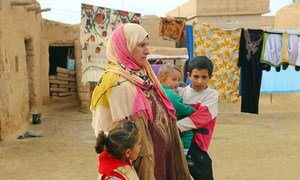Wednesday’s Daily Brief: 2020 humanitarian plan, malaria latest, greener tourism, people key to SDGs, Fall Armyworm
A recap of Wednesday’s stories: A record number of people will need humanitarian aid in 2020; WHO calls for more funding to protect women and children from malaria; the transport and tourism sectors are urged to tackle carbon emissions; a group of rights experts want to see more people helping make the SDGs a reality; Fall Armyworm pest sparks new global action plan; and how the UN is helping impoverished landlocked nations develop.
Humanitarian plan aims to assist 109 million vulnerable people in 2020

A record 168 million people worldwide will need help and protection in 2020, or roughly 1 in every 45 people on the planet, the UN’s top humanitarian official said on Wednesday.
Mark Lowcock was speaking in Geneva, where the UN and its humanitarian partners launched the $29 billion Global Humanitarian Overview 2020 to assist 109 million of the most vulnerable.
Mr. Lowcock said climate change, protracted conflicts and economic instability are devastating millions of lives, and the international community “must stand up, face facts, and fight back.”
Read our full report, here.
Step up funding to protect women and children from malaria: WHO

While more pregnant women and children are being protected against malaria than before, more fast-tracking and greater funding are needed to reinvigorate the global response, according to a report by the World Health Organization (WHO).
The World malaria report 2019, launched on Wednesday, notes a significant increase in the number of pregnant women and children in sub-Saharan Africa sleeping under insecticide-treated bed nets and using preventive medicines. However, progress has stalled in the hardest-hit countries.
WHO said pregnancy reduces a woman’s immunity to malaria, rendering her more susceptible to infection and at greater risk of illness, severe anaemia and death.
Our full coverage here.
Transport-related emissions from tourism on the rise

The World Tourism Organization (UNWTO) is calling for enhanced cooperation between the transport and tourism sectors to transform tourism for climate action.
The UN agency has released a report which analyzes the environmental impact of different modes of transport within the tourism sector.
It estimates that transport-related emissions from tourism will comprise 5.3 per cent of all man-man carbon dioxide emissions by 2030; up from five per cent in 2016.
The report was released on the sidelines of the UN climate summit taking place in Madrid.
March of Fall Armyworm must be halted says UN, unveiling new Global Action plan

The UN has launched a new three-year Global Action for Fall Armyworm Control plan to curb the growing spread of the invasive pest which is causing serious damage to food production and affecting millions of farmers across the world.
Fall Armyworm (FAW), a crop pest native to the Americas, has spread rapidly through Africa, and to the Near East and Asia in the past four years, said the Food and Agriculture Organization on Wednesday.
“It threatens food security of hundreds of millions of people and the livelihoods of smallholder farmers”, said FAO Director-General Qu Dongyu, speaking at the launch on the sidelines of the FAO's Council, the Organization's executive body.
“This is a global threat that requires a global perspective,” he stressed, urging the FAO member states “to greatly scale up the existing efforts” to prevent the further spread of this harmful pest to new regions.
Mr. Qu said that FAO is seeking to mobilize $500 million over the next three years to control Fall Armyworm. To this end, he proposed the establishment of a Global Action Fund - the first ever multi-partner trust fund aimed at addressing the threat - and encouraged countries to contribute to this funding mechanism.
The initiative also calls for increased partnerships to complement current FAO mechanisms such as Farmer Field Schools and South-South and Triangular Cooperation, Mr. Qu noted.
In particular, he added, it will feed into FAO’s new data-driven Hand-in-Hand initiative to better target interventions.
Leaders urged to increase people’s participation in meeting the SDGs

A group of UN human rights experts is calling on countries to boost people’s participation in achieving the Sustainable Development Goals (SDGs), aimed at delivering a more equitable future for all people and the planet by 2030.
It is critically important for States to ensure the broadest public participation in decision-making about development action, the experts said on Wednesday in a statement to mark the 33rd anniversary of the UN Declaration on Right to Development.
They stated that immediate action is “imperative”, not only because the SDGs are not on schedule, but also because popular dissatisfaction continues to grow, as evidenced by rising protests across more than 30 countries this year.
From landlocked to land-linked: how the UN is helping some of the world’s poorest countries

How can the international community turn some of the world’s poorest, landlocked countries, into thriving, land-linked nations? On Thursday, at UN Headquarters, Member States will renew commitments they have made, to lift the 32 countries designated as Landlocked Developing Countries, or LLDCs, out of poverty.
The two-day event in New York is officially known as the Midterm Review of the Vienna Programme of Action For Landlocked Countries, a 10-year initiative to improve the economies of the LLDCs, which suffer from, amongst other things, their challenging geography.
Here’s our news feature story.

